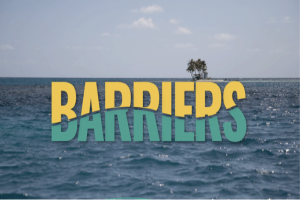Interactive student project about Central American barrier reef and climate change wins international awards

By Beth Hatcher
“Barriers,” an interactive media project produced by UNC Hussman School of Journalism and Media students, recently earned top honors at the Horizon Interactive Awards.
The international competition recognizes the world’s best websites, videos, online advertising, print media and mobile applications.
“Barriers,” produced by students in Professor Pat Davison’s spring 2020 MEJO 584: International Projects class, documents citizens of the Central American country of Belize confronting climate change, pollution and development as they work to preserve their culture and natural environment, which includes the world’s second-largest barrier reef.
The project won three Horizon awards — a Best In Category for Web: Magazine/News/Blog, a Gold for Web: Travel & Tourism, and another Gold for Short Film/Documentary.
“Students don't do this work to win awards. They are motivated by the opportunity and privilege of telling important stories that can make a difference in the world,” Davison said. “However, awards in a professional competition like Horizon are a great way for students to get attention in their job and internship searches, but more importantly, it is a validation that they are on the right path in their careers.”
“Barriers” adds to a list of past award-winning international projects, such as “Uprooted: The Faces of the Venezuelan Crisis," which won Horizon awards for Best in Category for School/ University websites and Gold for Short Film/ Documentary video. “Uprooted” told the story of Venezuelan families who have fled to Medellín, Colombia, to seek better lives.
Along with awards, international projects garner UNC Hussman students crucial professional skills, said Drew Wayland ’21, who worked as a reporter on the “Barriers” project.
“Working in the field was an invaluable experience. Although we had prepared for almost three months prior, we had to work efficiently and constantly to get the information and footage we needed during the 10 days we stayed in Belize,” Wayland said.
Watch a video from the "Barriers" project below.
Can You Hear Her? from UNC | Carolina Photojournalism on Vimeo.
Projects like “Barriers” represent UNC Hussman’s focus on immersive and experiential learning, Davison said.
“Immersive, experiential learning provides students an opportunity to confront issues that are affecting people firsthand. Learning about issues directly from the people who are experiencing them allows students to understand their own privilege, while promoting empathy and deeper understanding of what their story partners experience daily,” Davison said. “Students are then equipped to produce personal stories that connect with viewers.”
A group of 31 UNC Hussman students and coaches — including reporters, photographers and designers — went to Belize for the project just prior to widespread travel bans.
The teamwork needed to cover a complex topic from multiple angles and mediums was critical, noted Teaching Associate Professor Kate Sheppard, one of the project’s coaches. “These projects live or die by their ability to collaborate across medium, across skills, across methods,” she said. “While our video, photo, writing, design and developers are all uniquely talented, it is their ability to collaborate that sets this project apart.”
Watch another video from the "Barriers" project below.
Seeding the Sea from UNC | Carolina Photojournalism on Vimeo.
Adjunct Instructor Tamara Rice, a "MEJO 584" instructor who also served as a “Barriers” coach, noted that the project’s collaborative work paralleled professional media environments. “Immersive projects like this are crucial for students to get a glimpse of real-world media production when we all work as a team to produce successful multimedia experiences,” Rice said.
Besides its lessons in teamwork, the project’s timely subject matter excited Hanna Wondmagegn ’21, who worked as a photojournalist on “Barriers.”
“I was very excited about “Barriers” focusing on climate change. Climate change is a contested topic and also one that is very hard to understand and consume,” Wondmagegn said. “I've always loved the idea of using photo and video as a means to help audiences understand complex ideas on a personal level. Barriers is a great example of how multimedia can be used to serve a larger and productive goal.”
Learn more about “Barriers” at the project’s interactive website: barriers.unc.edu.
Images in main banner image of this article used courtesy of "Barriers" project.